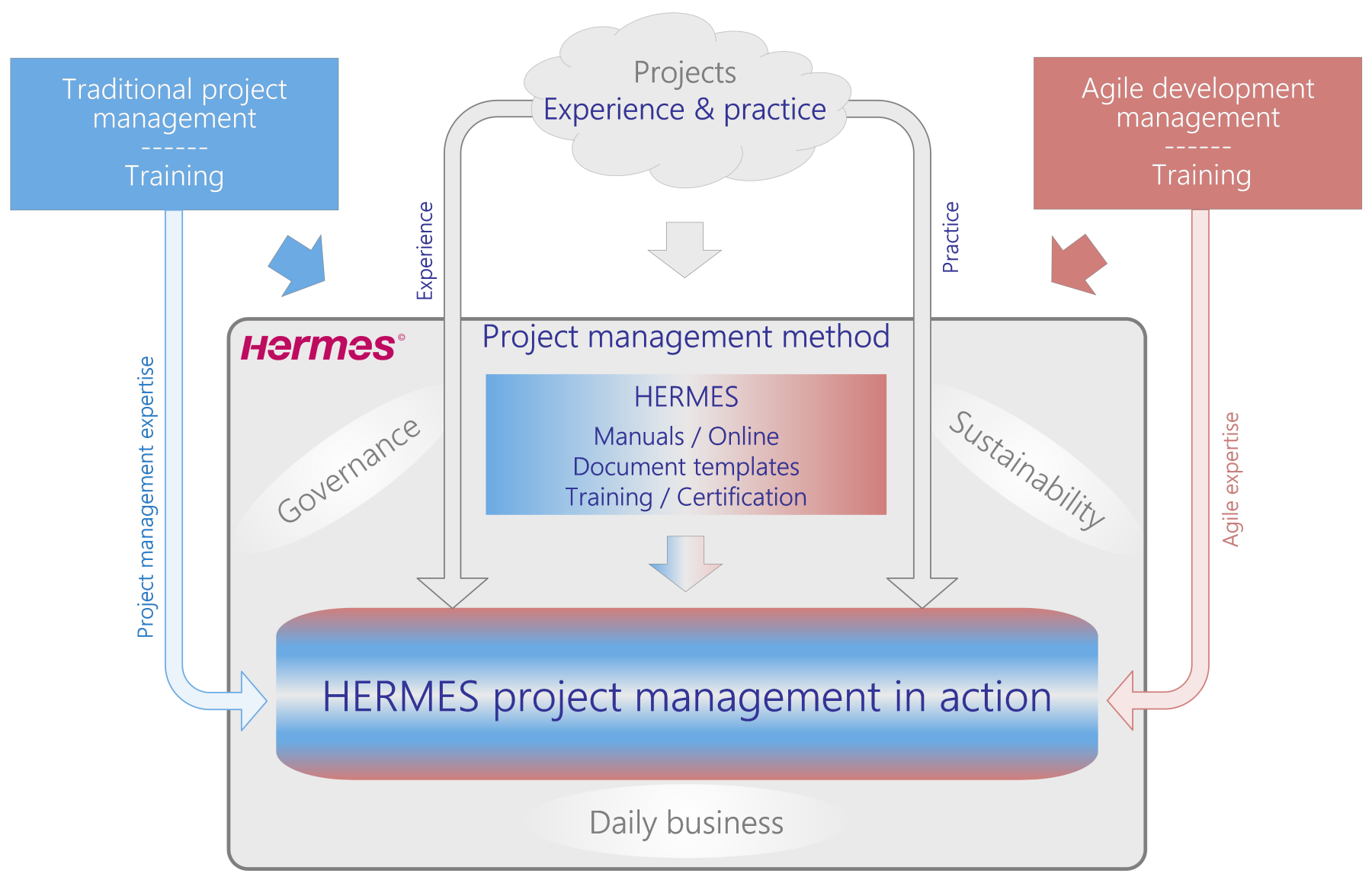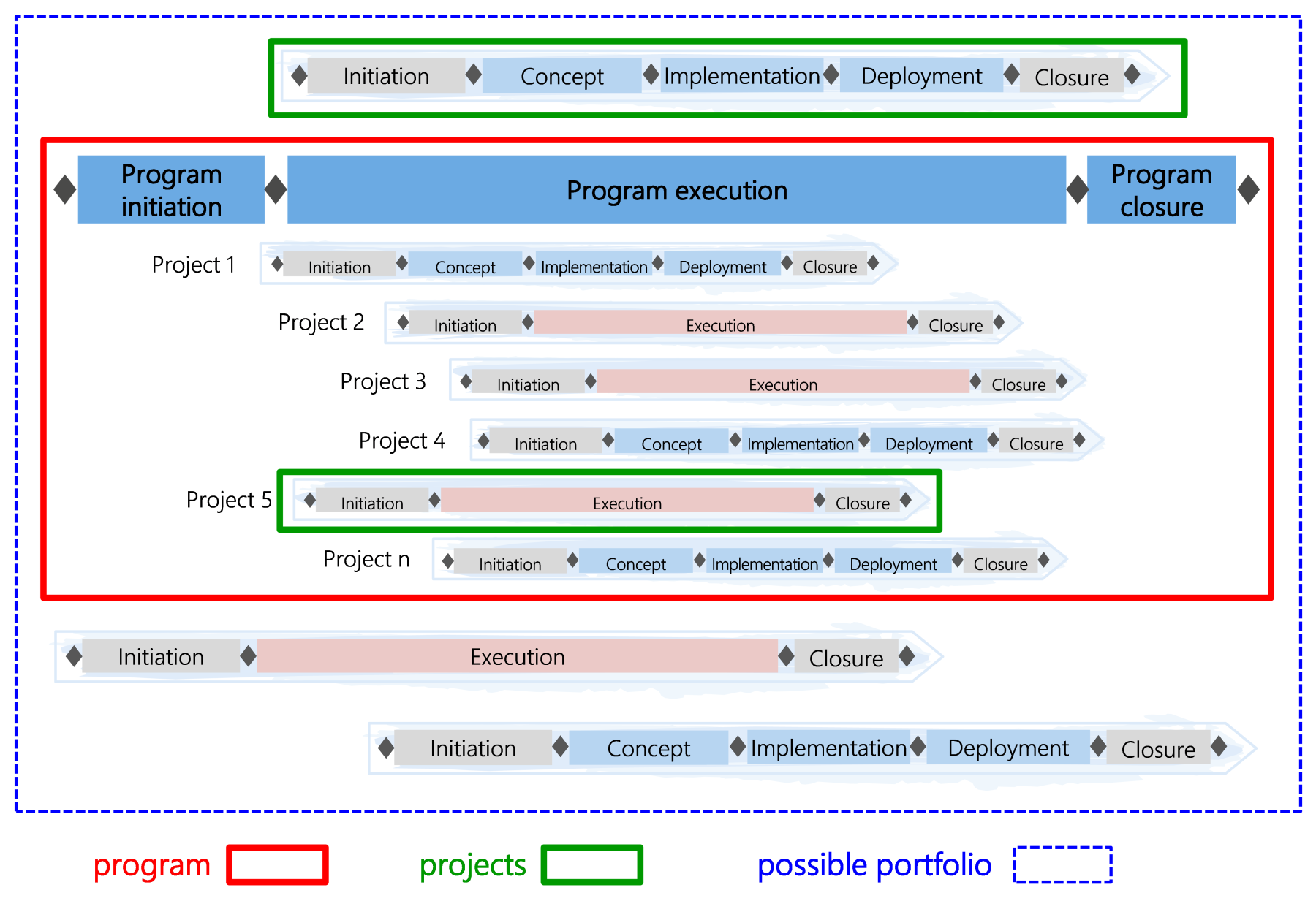Method overview
HERMES project management - big picture
The outcome diagram (Figure 1) provides a rough big picture for the outcomes of HERMES project management.

Figure 1: Overview of the HERMES modules and the essential outcomes along the phases
HERMES is an outcome-oriented process method; the focus is on the outcomes. The overview shows the essential outcomes of the individual modules along the phases as well as the rough dependencies and interrelationships. The oval iteration arrows in red symbolize the core of the iteration, the driving character of the product and IT system modules during agile development. The outcomes of the other modules are developed in sync with that iteration, likewise iteratively and incrementally.
What is HERMES project management?
HERMES project management is the holistic management method for carrying out projects and programs of various types in many fields of activity, such as organization adjustment, IT, and service and product development. As Figure 2 shows, HERMES portfolio management, HERMES project management, and HERMES application management are method components of equal value and jointly form the HERMES method.

Figure 2: The three top method components of the HERMES method
HERMES project management supports the steering, management, and execution of projects and accompanies the further development of organizational structures, products and services, IT and logistics systems, infrastructures, etc. with various levels of complexity and different features. A project can be divided into subprojects that deal with different aspects of the same project (e.g. subprojects for users, creators, operators for organization, IT, legal bases). Long-term or complex projects do not necessarily have to be structured as programs. They can be carried out as projects with implementation units.
As a method, HERMES project management has a clear, easy-to-understand structure with common terminology for all participants, has a modular design, and can be expanded. It is continuously updated and further developed.
The other two, equally positioned method components - portfolio management and application management - are not dealt with in detail in HERMES project management.
Project sizes supported by HERMES
To ensure the completeness of the information and the method as such, HERMES project management is designed for major projects of high complexity. This is not an appropriate fit for every project, however. With the sizing function provided in HERMES online, the standard scenarios are adjusted according to the actually determined project value. The project value is determined from a combination of factors such as lead time, size of the project team, stakeholder structure, and political urgency, all of which relate to the complexity of the underlying solution option according to the study. Based on the determined value of the envisaged project, the sizing function provides the project manager with the selected, appropriately tailored scenario together with adapted document templates.
The project sizes/values set in HERMES online should be seen as general standard assumptions. They can be adapted by the project management or core organization as needed.
Use of HERMES project management in practice
The HERMES project management method supports two approaches: The traditional phased approach as described in systems engineering* , hereinafter referred to as "traditional", and the iterative and incremental approach* , hereinafter referred to as "agile". The method provides a framework that makes it possible to embed different approaches and the corresponding project-specific methods in a uniform way.
Figure 3 shows the functional use of the HERMES project management method, illustrates the prerequisites for the project roles involved in carrying out the project, and shows how the application of the method requires other relevant methodological training or at least sound project practice: The project management method channels knowledge acquired in different areas, enhances it with HERMES-specific elements and terminology, and provides a homogeneous framework for all projects.

Figure 3: How HERMES project management works in practice
HERMES courses and certifications strengthen the required competence and expertise. This ensures the same manner of reporting and communication both within the project and in relation to the core organization, while at the same time meeting the accompanying framework requirements of HERMES project management (see Section 7, e.g. Governance). In this way, projects of all types can be anchored uniformly within the core organization, exhibiting the same level of integration into the operational processes regardless of the selected approach.
The project teams are supported in applying the approach selected for the project and in delivering the outcomes required by the project management method in a lean manner. This does not curtail the traditional and agile methods, but additional, binding method components are required and defined with regard to roles, tasks, or outcomes. The HERMES framework lays a structure over the selected approach that provides a uniform picture of all projects externally and communicates the same language internally to all project participants. This makes the selected project approach completely autonomous as such, so that it can be integrated into any organization.
Independently of the project type or approach, both planning and controlling are largely done in the same way. This also applies to methods supported in principle by HERMES, such as SAFe* and the process-based optimization approach DevOps*.
The interfaces of HERMES project management
HERMES project management covers the entire project life cycle and is outcome-oriented. It guarantees the compatibility of its standardized interfaces within the project and with the core organization, such as reporting, regardless of whether development is carried out in a traditional or agile manner.
HERMES terminology guarantees a common language and understanding between the core and project organizations, between the project and the program, and between project, application, and portfolio management.
Within the project organization, the project sponsor, project management, and user representative are the indispensable roles for the functioning of the interfaces, but also for the project as a whole. The project sponsor steers the project and has the overall responsibility for the project and for achievement of the project objectives. The project management manages and coordinates the project and determines its course. The user representative is responsible for solution development.
Agile development management with HERMES
The HERMES project management method is a project approach shell into which a specific agile development method can be inserted like a black box. HERMES does not go into any further detail on the development approach encapsulated in this way, but it does define relevant interfaces for the purpose of steering, management, communication, and reporting. These are the corresponding outcomes and specific roles.
The traditional and agile development processes have a fundamentally different understanding of the management of the roles of the hierarchy level of execution. While the traditional approach assumes that the project manager issues work orders, in the agile approach the work of the development team is steered by the user representative via the solution requirements, and the team organizes its work independently. The project manager manages the project, but the project manager is not allowed to interfere with the self-organization of the agile development team. As the representative of the agile development team, the user representative is the contact person for the project manager.
The terminology within agile development is not prescribed; it depends on the development method used in each case. Only the outcome interfaces and the terminology within the framework of project management are defined.
HERMES project management gives the project its uniform structure and a uniform framework. The focus is on the project life cycle; agile development management forms a black box as an encapsulated method. Agile development management determines the organization and steering of the development team and autonomously steers solution development within a predefined framework. The method-specific role models, processes, and rituals can be put into practice without interference - provided there is consensus within the core and project organization.
Positioning of program management
In organizations with far-reaching and comprehensive changes, a holistic management system is required to achieve objectives within a group of interrelated projects in a lean and coordinated manner. This management system is called program management and is an extension of project management. In program management, the projects are grouped together as part of a program.
Projects and programs can be managed side by side in a core organization. Figure 4 shows an example of a portfolio with traditionally and agilely managed projects and a program that includes other projects. The figure shows that a project can be stand-alone or part of a program. A program contains several projects. Projects and programs can be combined within a portfolio.

Figure 4: Simultaneous management of projects and programs in a core organization
HERMES project management creates a common understanding of project and program management. A prerequisite, however, is that the project partners involved in program management have the necessary skills to perform their role successfully. The extension of project management by program management is discussed in the appendix to this reference manual.
User information
The user information describes specific aspects of HERMES project management. User information forms the basis for a deeper understanding of the method, for example in relation to governance and sustainability. User information also shows how HERMES should be applied in specific situations and helps to reduce room for interpretation, for example in hybrid development or when using implementation units.